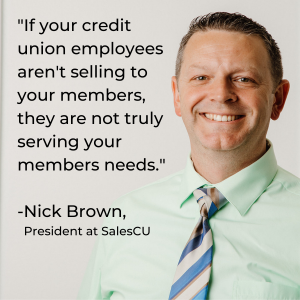“Too often, our members get what they ask for, but not what they truly need.”
By: Nick Brown
***As seen in Credit Union Business Magazine April 2017***
Credit union sales is a passion of mine. This is why, a few years ago I left my very comfortable credit union career and started SalesCU, a credit union specific sales consulting and training company. But it wasn’t always this way. In fact, early on in my career, I had a very different perspective on sales and the role sales played in the branch.
While still in my first credit union position as a teller, my focus was not on selling, but rather processing. I remember one memorable performance review I had. I had failed to meet my lofty sales goal (6 product sales p/month) 10 out of the previous 12 months. When asked about this by my managers I responded simply, “I process transactions, I am not a salesman.”
What I came to understand later, and what completely changed my perspective was that credit unions sell to serve. In fact, if credit union employees are not reaching out and selling to their members they are not truly serving the member’s needs.
One credit union I’ve worked with this past year, which has come to understand this as well, is Salt Lake-based, American United Federal Credit Union.
At nearly $200 million in assets and 20,000 members, American United is the product of a series of mergers and strategic partnerships over the past decade. The conglomeration of this “Family” of credit unions has created a lot of growth and given them an amazing presence in the Salt Lake area market. But growth in numbers didn’t necessarily translate into greater opportunity.
“One of our goals has always been to grow membership through mergers, but there has always been a subset of that goal to develop the relationship with each of those members as well.” Says Brittany Anderson, Director of Marketing & Member Development with American United. “Through our mergers, we were gaining new members, however, the relationship piece was missing. We realized that we weren’t reaching out to them to try to develop each relationship, provide them the service and products they needed, and show them how we can benefit their financial situation. By not developing those relationships, we ended up losing many.”
Anderson goes on to say “We successfully offered specials, but the more and more promotions we offered, the more we realized we weren’t seeing the success that we should be. We were pushing out information and displaying nice looking marketing and graphics, but what we were missing was the relationship on the front lines to capture and close the business that the marketing brought in. We realized that we were in a very reactive state of mind, only helping the member with exactly what they were asking for.”
What American United was experiencing with its reactive sale state of mind is the same for many other credit unions. This reactive sales approach is sometimes referred to as “Order Taker”. In a reactive (or order taker) sales mode, the credit union will only get to services the financial needs the members ask for leaving them under-served. And often without guidance from employees, the credit union will often find their members with products and services spread out amongst a number of financial institutions rather than with them.
Reactive sales cultures generally develop on their own where efforts have not been made on the part of leadership to provide sales-specific training, coaching, and accountability to sales goals. Generally, employees in a reactive sales model see sales as a bother to their members and will avoid sales discussions. The order taker approach does not engage members and ends up giving them permission to look elsewhere for their financial needs.
So how do credit unions who are stuck in this reactive sales approach make the change? Anderson says for them it started with leadership. “It seemed like a change was occurring in the way leadership was thinking about our approach. We started talking more and more about “sales” and realized within our credit union that we really needed to shift that culture on our front line from being reactive to proactive.”
Like American United, leaders of credit unions that are stuck in this reactive sales approach need to recognize a change must take place before a switch to a proactive approach can happen. Once the decision has been made they need to take action and provide a few things.
American United started by trying a few things to get employees to see themselves as salespeople. They started by implementing an incentive program to encourage cross-selling and they started running month-long sales competitions that were built around the marketing promotions. It worked, too. During those months when the contests were being held Anderson says it produced so much more than we had been doing in the past. Unfortunately though, the success typically only lasted as long as the contest, and then it was back to business as usual.
“We really needed some structure to keep us going throughout the year. We were missing that level of organization in our sales efforts to help our front line realize who to reach out to and what the cross-sale opportunities were for each member.” For American United, it was easy for employees to focus on one area and sell the smaller products and services but still very difficult for them to engage the member in a discussion to learn what the member’s true financial needs were and find a way to solve them.
“It took some time,” Anderson says “to help our front line realize that when a member is requesting a signature loan, for example, that it was up to them to make sure a signature loan offered the best solution to their financial needs. Often, when studying the member’s credit report and specific financial situation, we can see that by using equity from an owned vehicle, or other collateral they may have, we were able to offer a better rate and lower payments while still fulfilling their original need of a loan.”
The next step for American United would be to provide credit union specific sales training. A full day of class training was first delivered to branch managers, loan officers, and cross-trained tellers. Following the training, they were each given sales-specific leads and goals to immediately start calling on and help them apply what they had learned right away. To support the training, the credit union’s newly promoted Sales Manager and Trainer made monthly visits to branch staff to follow-up, and where needed coach and retain the content they had received.
With training complete and employees challenged to start making sales calls and discussing products and services with members right away, Anderson says the credit union saw immediate results.
“What was interesting was that we had immediate success. The numbers we saw from that first month were better than we could have hoped. To go from one end of the spectrum, from a reactive culture to the opposite end of the spectrum, striving to be proactive, was amazing, and our loan production skyrocketed. More and more of our branches started reaching their goals, and eyes started opening. It showed employees that by identifying the opportunities that really benefit that members’ finances, the number of products and services per household increased. It really gave us that confidence that we needed to say ‘Okay, yes, this is going to be successful so now we can put our full resources behind it.’ ”
This training rolled out in January of 2016 and the success continued throughout the year. In 2015 American United Loan Growth was a little more than negative 3%. Their team finished with positive loan growth of 14%, just over a 17% turnaround. But this success didn’t come without a price. Not all of the employees who received the training were able to make the adjustment to the new sales approach.
“It’s been interesting to see the shift in mentality. I think that shift can be a really hard one for someone who’s been doing the same thing the same way for a really long time. We did have a few people who just could not equate “sales” with “service” and never felt fully comfortable, and they eventually left.”
Like American United, other credit unions I have worked with also see immediate results from their sales training. One of the keys to sustaining that sales success throughout the year has been the continued coaching employees are receiving from the sales manager and trainer. With employees receiving continued support, coaching, and encouragement from her and from their branch leadership, they are staying accountable and consistent.
Credit unions exist to be their member’s primary resource for financial products and services, to be their member’s financial advocate. The employee must be the one that reaches out to the member to offer the options and solutions to their member’s needs. Some may call this sales, which it defiantly is. American United has a different name for it.
“What we have seen along the way is that by being proactive for our members, showing them how we can benefit their financial picture, and not necessarily just giving them what they think they need or what they are asking for, we are simultaneously providing excellent member service.”







